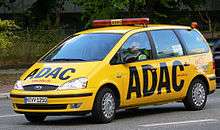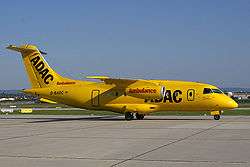ADAC
The ADAC (Allgemeiner Deutscher Automobil-Club e.V., meaning General German Automobile Club) is an automobile association in Germany, founded on May 24, 1903, as German Motorbiker Association (Deutsche Motorradfahrer-Vereinigung), and given its present name in 1911.


_of_ADAC_at_G%C3%B3raszka_Air_Picnic_2005.jpg)

With more than 21.2 million members in December 2019,[1] it is the largest automobile club in Europe.
Overview
Both the ADAC, and its older rival AvD (the organizer of the German Grand Prix), are members of the FIA and the DMSB. The European Grand Prix, the former ADAC Eifelrennen, the 24 Hours Nürburgring and many other races are hosted by ADAC.
The ADAC also operates a large fleet of mobile mechanics in yellow cars that assist motorists in trouble - the Yellow Angels. The ADAC runs its own modification center whereby ordinary vans are turned into mobile garages (pictures only depict Ford Galaxies) in 55 man-hours.[2]
In addition to this, the ADAC provides 55 air ambulance helicopters[3]for urgent medical rescues in Germany, strategically placed so that any location can be reached within 15 minutes. Air ambulance jets are used by the ADAC to rescue their members with a "PLUS" membership or customers who own an ADAC international travel insurance from any location worldwide in the case of accident or extreme sickness. The ADAC also offers its membership to non German residents, having signed contracts with automobile clubs worldwide. In the UK, it is possible to have breakdown recovery through the local AA while having an ADAC membership.
The ADAC is publisher of the magazine with one of the largest distribution in Germany, ADAC Motorwelt . The magazine is distributed four times a year to ADAC members containing features articles of common interest to all participants of public traffic, such as product tests, safe driving tips and also places to visit by car or motorbike.[4]
On June 3, 2008, the ADAC suspended its involvement with the FIA over the scandal surrounding Max Mosley and his subsequent retention as FIA president.[5]
Affiliation
ADAC is affiliated to the following organisations:
- FIA, the international automobile federation
- FIVA, the international historic vehicles federation[6]
- Euro NCAP, a crash test consortium
- Pro Mobilität, a Berlin-based lobbying organisation promoting the expansion and maintenance of the road network
- Network European Movement Germany
- EuropeNet24 (Europe-wide breakdown assistance for HGVs)
History
The ADAC was founded on 24 May 1903 in Stuttgart's Hotel Silber (Silver Hotel), as the Deutsche Motorradfahrer-Vereinigung (the German Motorbikers' Association), with an annual membership fee of six Marks. Following a name change in 1911 it became the Allgemeiner Deutscher Automobil-Club The Prussian Eagle, which for many years was the main feature of the ADAC badge was chosen as the organisation's symbol in appreciation of the support received from the German Kaiser who was also Prussia's hereditary king.
The ADAC break-down assistance service was launched in Germany in 1927.[7]
During the Nazi period, starting in 1934, all motorists' organizations and clubs were replaced by "Der Deutsche Automobil-Club e.V." (the German Car Club) which was closely associated with the National Socialist Motor Corps. After the Second World War the ADAC was re-established in Bavaria in 1946, and from 1948 it was also permitted to operate in the other western occupied zones which in 1949 would become the Federal Republic of Germany.
In 1954 Heinz Frölich became the first of (in that year) 56 ADAC patrolmen, equipped with a motorbike-sidecar combination,[8] on which the side car consisted of a large compartment filled with tools and parts for roadside repairs. These original ADAC "Gelbe Engel" ("Yellow Angels") used "NSU Konsul" motorbikes.[9]
At the end of 1962 ADAC announced the retirement of their motor-bike-sidecar combinations which would be replaced by 40 appropriately equipped Volkswagen Beetles.[10] Equipment on the new cars included a flashing roof-light, repair tools, a radio-based communication device, compressed air canisters, a spade and broom set, and a basic "doctor-kit" incorporating blood-plasma.[10]
In 1974 the organisation had 3.8 million members at a time when there were 19.0 million passenger cars registered in Germany: by 1990 membership had risen to 10.2 million, with 35.5 million passenger cars registered in the country, so that ADAC membership has grown more than twice as fast as national car ownership.[11] Growth rates during the ensuing twenty years were greatly boosted by German reunification.
May 2012 was when the organization welcomed its 18 millionth member,[12] a further milestone being reached in May 2013 as the ADAC fitted out its 10,000th roadside assistance vehicle, a Volkswagen Touran, kitted out with several hundred different tools and replacement parts.[13]
At the end of 2019 ADAC had 21,2 million members.[14]
ADAC road patrol
Breakdown assistance is ADAC’s core service. The ADAC road patrol dates back to 1928 when the ADAC-Straßen-Hilfsdienst (roadside assistance service) was founded. Back then, the patrols used sidecar motorcycles. After World War Two, during which ADAC was forced to stop operations, the provision of breakdown assistance services was resumed by founding the ADAC-Straßenwacht (road patrol) in 1954. In 1990, the road patrol started covering the New Länder. In 1951, ADAC started to organise assistance also outside Germany.[15]
ADAC operates a fleet of more than 1,700 yellow road patrol vehicles (Yellow Angels). In the 1960s and 1970s, the yellow Beetles were a fixture on German roads. Today, ADAC deploys MPVs, each carrying up to 290kg of equipment ranging from the always right tools to a digital diagnostic tool to spare parts and replacement batteries. In the case of a car breakdown, the member can request assistance over the phone or emergency roadside telephone, over the Internet or via smartphone app: a dispatcher at one of the five breakdown assistance centres will take down the necessary data and forward them to the nearest available road patrol who will call the member several minutes before their arrival.[16]
ADAC also provides Europe-wide breakdown assistance for HGVs. In Germany, ADAC uses special breakdown assistance vehicles for HGVs. In other European countries, ADAC partners provide assistance.
In 2019, the ADAC road patrols and mobility partners attended to 3.7m callouts, i.e. almost 10,300 per day. In keeping with the previous years, the breakdowns were usually due to problems with the automotive battery at nearly 42%.[17]
Lobbying and public relations
ADAC is among Germany’s most influential associations and one of the biggest lobbying associations worldwide. Public relations activities focus on topics such as maintaining motorised mobility, preventing speed limits, traffic law and fines, the safety of tunnels and car ferries as well as road safety education.
In recent years, ADAC has developed a growing interest for other transport operators and modes, for instance, by conducting tests on local public transport and urban cycling. ADAC regularly issues press releases and publishes the ADAC Motorwelt club magazine to inform its approx. 21.2m members.
In 2020, the ADAC Motorwelt has become a quarterly publication (four issues per year). In the first quarter of 2020, the Burda affiliate BCN started to handle everything from production and printing to editorial services to marketing to distribution of the ADAC Motorwelt; the mobility club continues to be its publisher, and editor-in-chief Martin Kunz continues to oversee the content. At the same time, ADAC enhances and expands its digital communication channels.[18]
Starting in 2020, the new ADAC Motorwelt is available at the ADAC local offices, travel agencies and driver safety locations as well as the EDEKA and Netto supermarkets. All members need to do to get a copy of the magazine is show their membership card.[19]
Research
ADAC is an active member for the European Road Assessment Program (EuroRAP) in Germany.[20] ADAC regularly publishes maps showing safety characteristics of German roads.[21]
These maps based on EuroRAP's Road Protection Score Protocol (or Star Rating Protocol) is a measure of how well a road protects road users in the event of an accident. Data on road characteristics is gathered by driving through road inspections using a specially equipped RPS inspection vehicle (Straßentest in German). Trained assessors then rate the safety features and hazards on the inspected road and use standardised formula to produce a safety star rating, which is comparable across Europe.[22]
ADAC also undertakes road inspections on behalf of other EuroRAP members, including the Road Safety Foundation in the UK.[23]
Campaigning for Safe Road Design
The European Campaign for Safe Road Design is a partnership between 28 major European road safety stakeholders that is calling for the EC to invest in safe road infrastructure initiatives which could cut deaths on European roads by 33% in less than a decade.[24] ADAC is the campaign's partner in Germany.
See also
- Breakdown (vehicle)
- Breakdown Cover
- European Campaign for Safe Road Design
- EuroRAP
References
- "ADAC wächst 2019 weiter: Mehr als 21 Millionen Mitglieder". www.adac.de (in German). Retrieved 2020-04-06.
- lifePR (c) 2002-2020 (2007-06-30). "10 Jahre ADAC Technik-Zentrum Landsberg, Allgemeiner Deutscher Automobil-Club e.V (ADAC e.V.), Pressemitteilung - lifePR". www.lifepr.de (in German). Retrieved 2020-04-09.
- "ADAC Luftrettung". ADAC Luftrettung (in German). Retrieved 2020-04-06.
- "ADAC Motorwelt bei BCN | Burda Community Network". BCN (in German). Retrieved 2020-04-06.
- "Mosley stays on as FIA president". BBC News. 2008-06-03. Retrieved 2010-04-23.
- "Internationale Zusammenarbeit | ADAC e.V." www.adac.de (in German). Retrieved 2020-04-09.
- "Altes vom Auto: Meldungen aus 125 Jahren:Tops und Flops (a summary of the highlights and lowlights of the first 125 years of motoring history)". Auto Motor u. Sport. Heft. 4: 16. 27 January 2011.
- "Engel Heinz am Start". ADAC Motorwelt. 2: 10. February 2014.
- "Die Geschichte des ADAC | ADAC". www.adac.de (in German). Retrieved 2020-04-09.
- "Vor 40 Jahren: Die Kaefer kommen - Strassenwacht auf vier Raedern". Auto, Motor und Sport. 2003. 1: 162. 23 December 2002.
- "60 Jahre BRD". ADAC Motorwelt. 6: 38–42. June 2009.
- "Glueckwunsch zum Achtzehnten: Der ADAC wird zwar nicht volljaehrig, hat aber trotzdem allen Grund zu feiern: Mit SJ begruesst der club sein 18-Millionstes Mitglied. Sie darf nun...". ADAC Motorwelt. 2012. 5: 84–86. May 2012.
- "10 000 Autos fuer die Gelben Engel: Seit 1954 bekommt jedes Strassenwachtfahrzeug eine Nummer - von 1 bis 10 ,,,...". ADAC Motorwelt. 2013. 5: 42–44. May 2013.
- "ADAC wächst 2019 weiter: Mehr als 21 Millionen Mitglieder". www.adac.de (in German). Retrieved 2020-04-06.
- "1954-1963". www.adac.de (in German). Retrieved 2020-04-09.
- "Straßenwacht des ADAC - Helfer aus Leidenschaft!". www.adac.de (in German). Retrieved 2020-04-09.
- "Pannenhilfebilanz 2019: Mehr als 10.000 Einsätze pro Tag". www.adac.de (in German). Retrieved 2020-04-09.
- "ADAC Motorwelt bei BCN | Burda Community Network". BCN (in German). Retrieved 2020-04-09.
- "Die Motorwelt 2020: Das neue Clubmagazin | ADAC". www.adac.de (in German). Retrieved 2020-04-09.
- "EuroRAP Partners". EuroRAP. Retrieved 2009-06-04.
- "Star Rating Maps Germany". EuroRAP. Archived from the original on 2012-02-17. Retrieved 2009-06-04.
- "What is Star Rating?". EuroRAP. Archived from the original on 2008-03-16. Retrieved 2009-06-04.
- "RPS Fleet". EuroRAP. Archived from the original on 28 June 2009. Retrieved 2009-06-04.
- "About the campaign". European Campaign for Safe Road Design. Archived from the original on 2010-01-22. Retrieved 2009-06-04.
External links
| Wikimedia Commons has media related to ADAC. |

- ADAC official website
- Early documents and clippings about ADAC in the 20th Century Press Archives of the ZBW